Evidence Based Nursing: Critique of Research Report - Study
VerifiedAdded on 2023/04/25
|12
|3211
|324
Report
AI Summary
This paper presents a comprehensive critique of a research study by Härkänen et al. (2015) focusing on factors related to medication errors in clinical care. The critique covers substantive and theoretical dimensions, assessing the relevance of the research problem, the appropriateness of the conceptual framework, and the congruence between research questions and methods used. Methodological dimensions are examined, including the research design, study population, data collection methods, and validity. Ethical dimensions such as confidentiality, informed consent, and vulnerability are also evaluated, alongside a discussion of ethical approval processes. Finally, the interpretive dimensions are analyzed, focusing on the discussion section and the presentation of results, highlighting both strengths and areas for improvement in the original study. This critique provides a thorough evaluation of the research, offering insights into its validity, reliability, and ethical considerations.
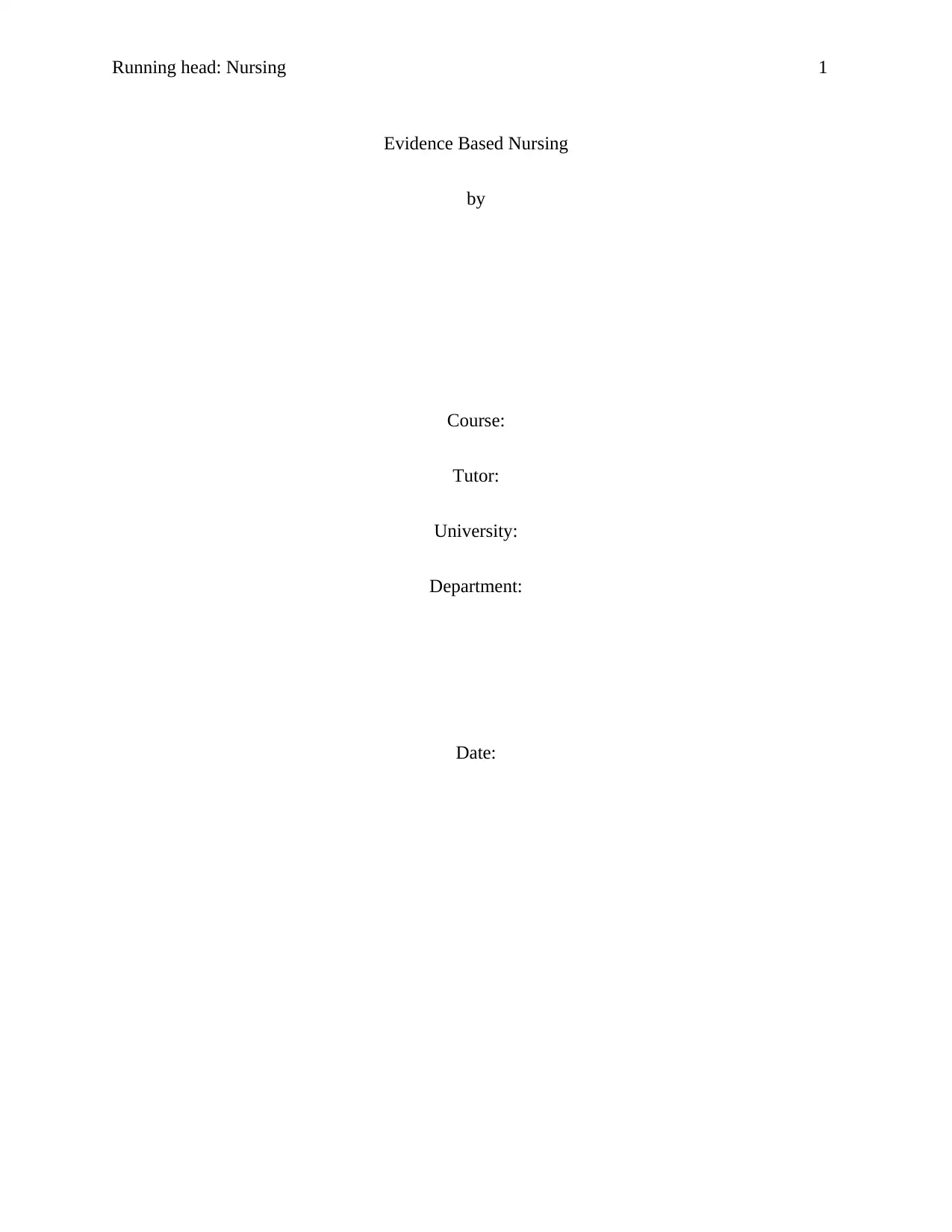
Running head: Nursing 1
Evidence Based Nursing
by
Course:
Tutor:
University:
Department:
Date:
Evidence Based Nursing
by
Course:
Tutor:
University:
Department:
Date:
Paraphrase This Document
Need a fresh take? Get an instant paraphrase of this document with our AI Paraphraser
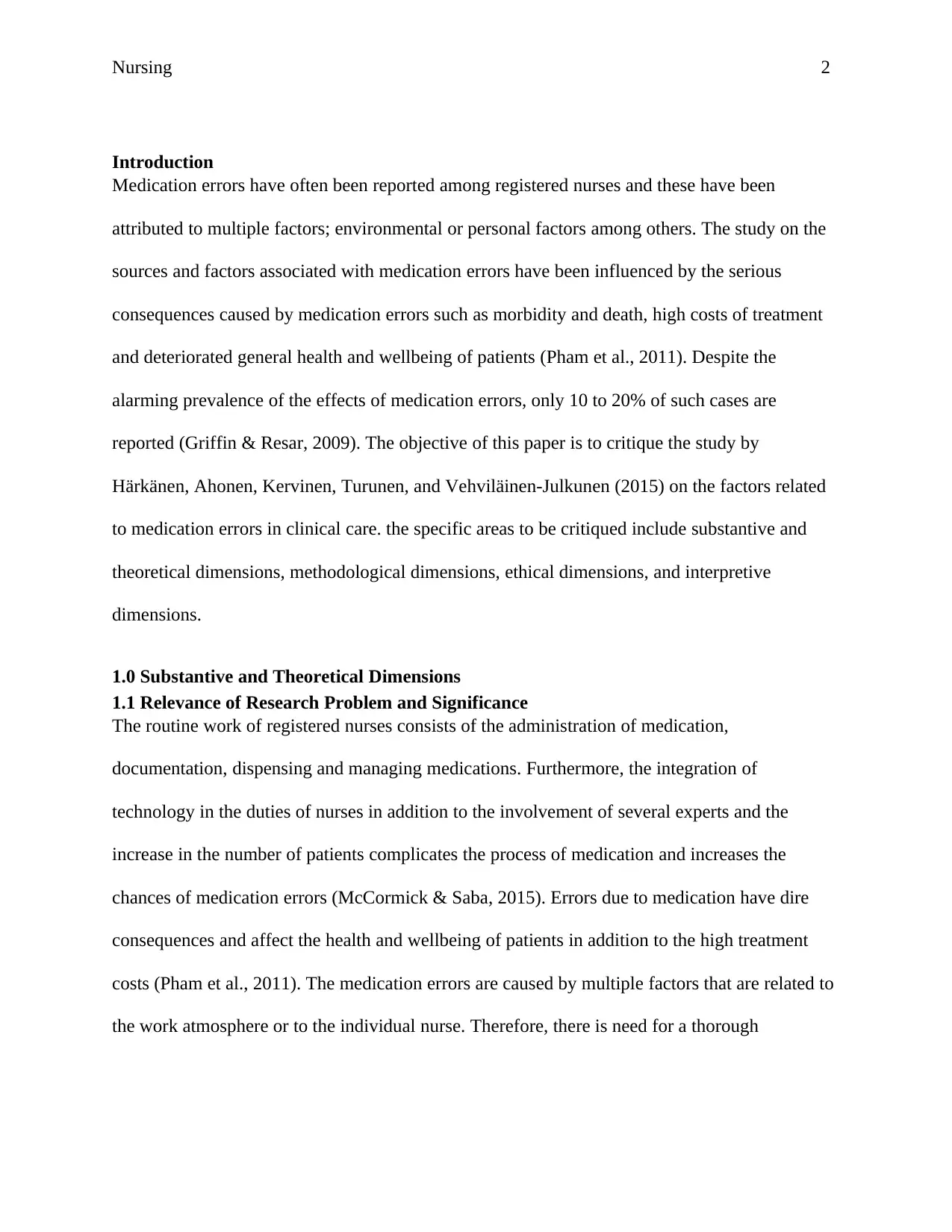
Nursing 2
Introduction
Medication errors have often been reported among registered nurses and these have been
attributed to multiple factors; environmental or personal factors among others. The study on the
sources and factors associated with medication errors have been influenced by the serious
consequences caused by medication errors such as morbidity and death, high costs of treatment
and deteriorated general health and wellbeing of patients (Pham et al., 2011). Despite the
alarming prevalence of the effects of medication errors, only 10 to 20% of such cases are
reported (Griffin & Resar, 2009). The objective of this paper is to critique the study by
Härkänen, Ahonen, Kervinen, Turunen, and Vehviläinen‐Julkunen (2015) on the factors related
to medication errors in clinical care. the specific areas to be critiqued include substantive and
theoretical dimensions, methodological dimensions, ethical dimensions, and interpretive
dimensions.
1.0 Substantive and Theoretical Dimensions
1.1 Relevance of Research Problem and Significance
The routine work of registered nurses consists of the administration of medication,
documentation, dispensing and managing medications. Furthermore, the integration of
technology in the duties of nurses in addition to the involvement of several experts and the
increase in the number of patients complicates the process of medication and increases the
chances of medication errors (McCormick & Saba, 2015). Errors due to medication have dire
consequences and affect the health and wellbeing of patients in addition to the high treatment
costs (Pham et al., 2011). The medication errors are caused by multiple factors that are related to
the work atmosphere or to the individual nurse. Therefore, there is need for a thorough
Introduction
Medication errors have often been reported among registered nurses and these have been
attributed to multiple factors; environmental or personal factors among others. The study on the
sources and factors associated with medication errors have been influenced by the serious
consequences caused by medication errors such as morbidity and death, high costs of treatment
and deteriorated general health and wellbeing of patients (Pham et al., 2011). Despite the
alarming prevalence of the effects of medication errors, only 10 to 20% of such cases are
reported (Griffin & Resar, 2009). The objective of this paper is to critique the study by
Härkänen, Ahonen, Kervinen, Turunen, and Vehviläinen‐Julkunen (2015) on the factors related
to medication errors in clinical care. the specific areas to be critiqued include substantive and
theoretical dimensions, methodological dimensions, ethical dimensions, and interpretive
dimensions.
1.0 Substantive and Theoretical Dimensions
1.1 Relevance of Research Problem and Significance
The routine work of registered nurses consists of the administration of medication,
documentation, dispensing and managing medications. Furthermore, the integration of
technology in the duties of nurses in addition to the involvement of several experts and the
increase in the number of patients complicates the process of medication and increases the
chances of medication errors (McCormick & Saba, 2015). Errors due to medication have dire
consequences and affect the health and wellbeing of patients in addition to the high treatment
costs (Pham et al., 2011). The medication errors are caused by multiple factors that are related to
the work atmosphere or to the individual nurse. Therefore, there is need for a thorough
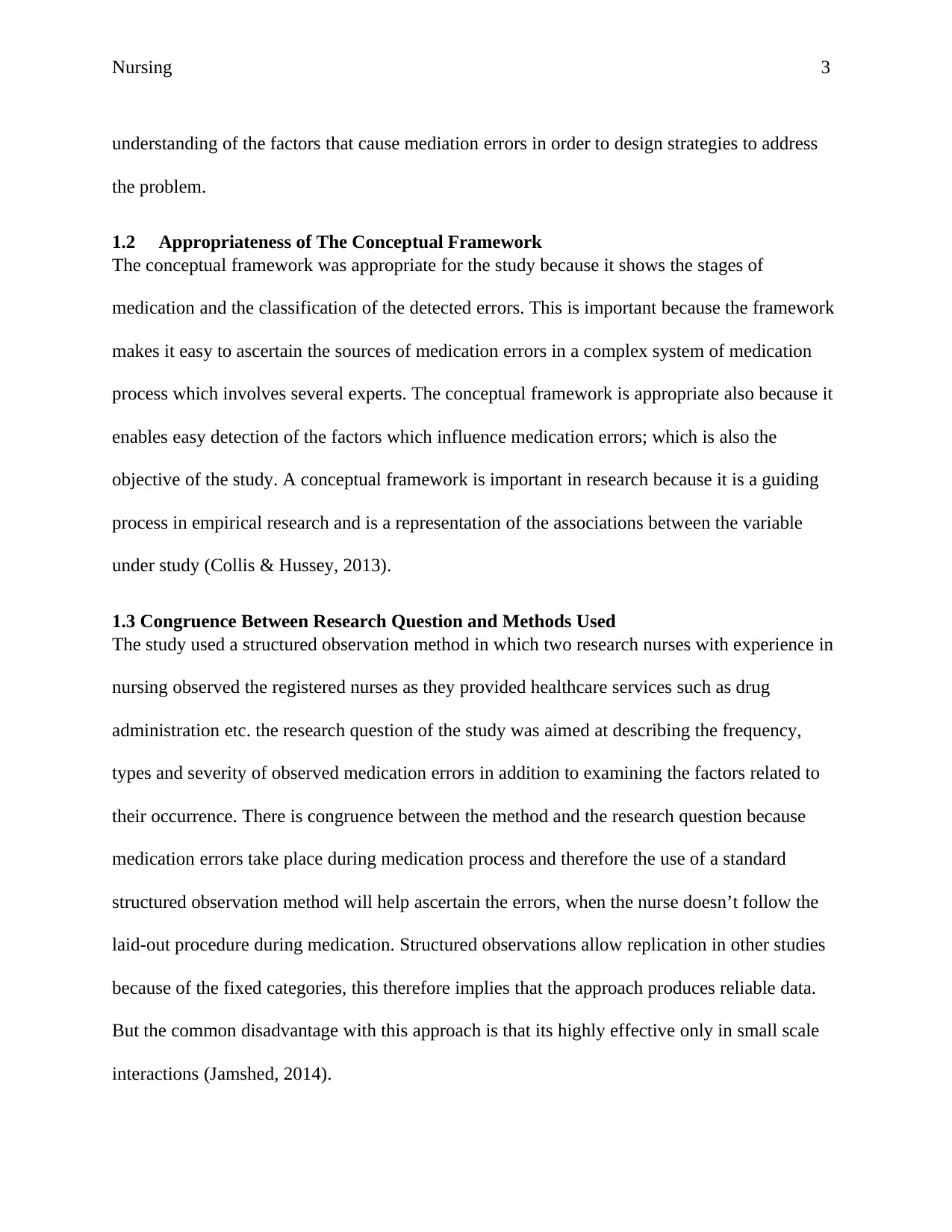
Nursing 3
understanding of the factors that cause mediation errors in order to design strategies to address
the problem.
1.2 Appropriateness of The Conceptual Framework
The conceptual framework was appropriate for the study because it shows the stages of
medication and the classification of the detected errors. This is important because the framework
makes it easy to ascertain the sources of medication errors in a complex system of medication
process which involves several experts. The conceptual framework is appropriate also because it
enables easy detection of the factors which influence medication errors; which is also the
objective of the study. A conceptual framework is important in research because it is a guiding
process in empirical research and is a representation of the associations between the variable
under study (Collis & Hussey, 2013).
1.3 Congruence Between Research Question and Methods Used
The study used a structured observation method in which two research nurses with experience in
nursing observed the registered nurses as they provided healthcare services such as drug
administration etc. the research question of the study was aimed at describing the frequency,
types and severity of observed medication errors in addition to examining the factors related to
their occurrence. There is congruence between the method and the research question because
medication errors take place during medication process and therefore the use of a standard
structured observation method will help ascertain the errors, when the nurse doesn’t follow the
laid-out procedure during medication. Structured observations allow replication in other studies
because of the fixed categories, this therefore implies that the approach produces reliable data.
But the common disadvantage with this approach is that its highly effective only in small scale
interactions (Jamshed, 2014).
understanding of the factors that cause mediation errors in order to design strategies to address
the problem.
1.2 Appropriateness of The Conceptual Framework
The conceptual framework was appropriate for the study because it shows the stages of
medication and the classification of the detected errors. This is important because the framework
makes it easy to ascertain the sources of medication errors in a complex system of medication
process which involves several experts. The conceptual framework is appropriate also because it
enables easy detection of the factors which influence medication errors; which is also the
objective of the study. A conceptual framework is important in research because it is a guiding
process in empirical research and is a representation of the associations between the variable
under study (Collis & Hussey, 2013).
1.3 Congruence Between Research Question and Methods Used
The study used a structured observation method in which two research nurses with experience in
nursing observed the registered nurses as they provided healthcare services such as drug
administration etc. the research question of the study was aimed at describing the frequency,
types and severity of observed medication errors in addition to examining the factors related to
their occurrence. There is congruence between the method and the research question because
medication errors take place during medication process and therefore the use of a standard
structured observation method will help ascertain the errors, when the nurse doesn’t follow the
laid-out procedure during medication. Structured observations allow replication in other studies
because of the fixed categories, this therefore implies that the approach produces reliable data.
But the common disadvantage with this approach is that its highly effective only in small scale
interactions (Jamshed, 2014).
⊘ This is a preview!⊘
Do you want full access?
Subscribe today to unlock all pages.

Trusted by 1+ million students worldwide
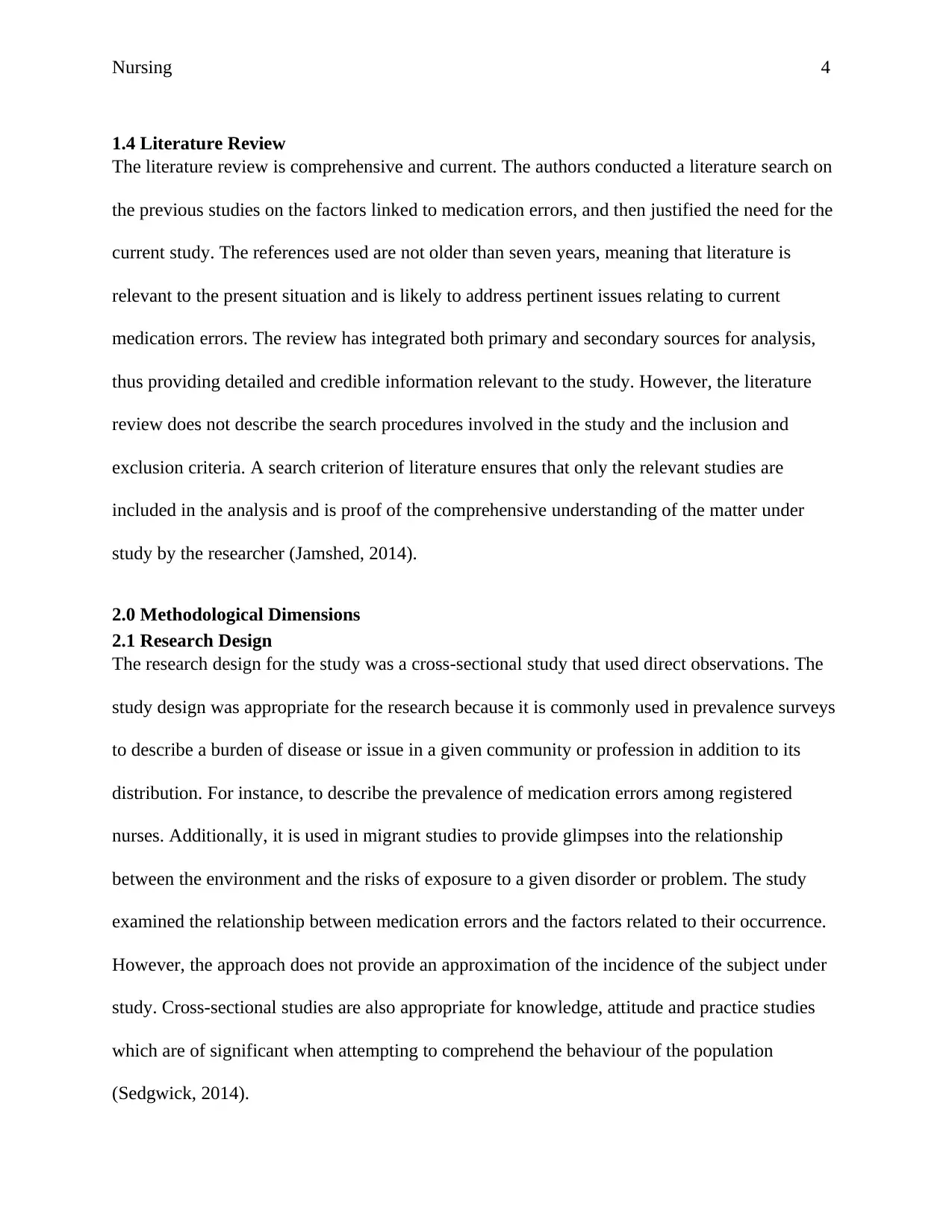
Nursing 4
1.4 Literature Review
The literature review is comprehensive and current. The authors conducted a literature search on
the previous studies on the factors linked to medication errors, and then justified the need for the
current study. The references used are not older than seven years, meaning that literature is
relevant to the present situation and is likely to address pertinent issues relating to current
medication errors. The review has integrated both primary and secondary sources for analysis,
thus providing detailed and credible information relevant to the study. However, the literature
review does not describe the search procedures involved in the study and the inclusion and
exclusion criteria. A search criterion of literature ensures that only the relevant studies are
included in the analysis and is proof of the comprehensive understanding of the matter under
study by the researcher (Jamshed, 2014).
2.0 Methodological Dimensions
2.1 Research Design
The research design for the study was a cross-sectional study that used direct observations. The
study design was appropriate for the research because it is commonly used in prevalence surveys
to describe a burden of disease or issue in a given community or profession in addition to its
distribution. For instance, to describe the prevalence of medication errors among registered
nurses. Additionally, it is used in migrant studies to provide glimpses into the relationship
between the environment and the risks of exposure to a given disorder or problem. The study
examined the relationship between medication errors and the factors related to their occurrence.
However, the approach does not provide an approximation of the incidence of the subject under
study. Cross-sectional studies are also appropriate for knowledge, attitude and practice studies
which are of significant when attempting to comprehend the behaviour of the population
(Sedgwick, 2014).
1.4 Literature Review
The literature review is comprehensive and current. The authors conducted a literature search on
the previous studies on the factors linked to medication errors, and then justified the need for the
current study. The references used are not older than seven years, meaning that literature is
relevant to the present situation and is likely to address pertinent issues relating to current
medication errors. The review has integrated both primary and secondary sources for analysis,
thus providing detailed and credible information relevant to the study. However, the literature
review does not describe the search procedures involved in the study and the inclusion and
exclusion criteria. A search criterion of literature ensures that only the relevant studies are
included in the analysis and is proof of the comprehensive understanding of the matter under
study by the researcher (Jamshed, 2014).
2.0 Methodological Dimensions
2.1 Research Design
The research design for the study was a cross-sectional study that used direct observations. The
study design was appropriate for the research because it is commonly used in prevalence surveys
to describe a burden of disease or issue in a given community or profession in addition to its
distribution. For instance, to describe the prevalence of medication errors among registered
nurses. Additionally, it is used in migrant studies to provide glimpses into the relationship
between the environment and the risks of exposure to a given disorder or problem. The study
examined the relationship between medication errors and the factors related to their occurrence.
However, the approach does not provide an approximation of the incidence of the subject under
study. Cross-sectional studies are also appropriate for knowledge, attitude and practice studies
which are of significant when attempting to comprehend the behaviour of the population
(Sedgwick, 2014).
Paraphrase This Document
Need a fresh take? Get an instant paraphrase of this document with our AI Paraphraser
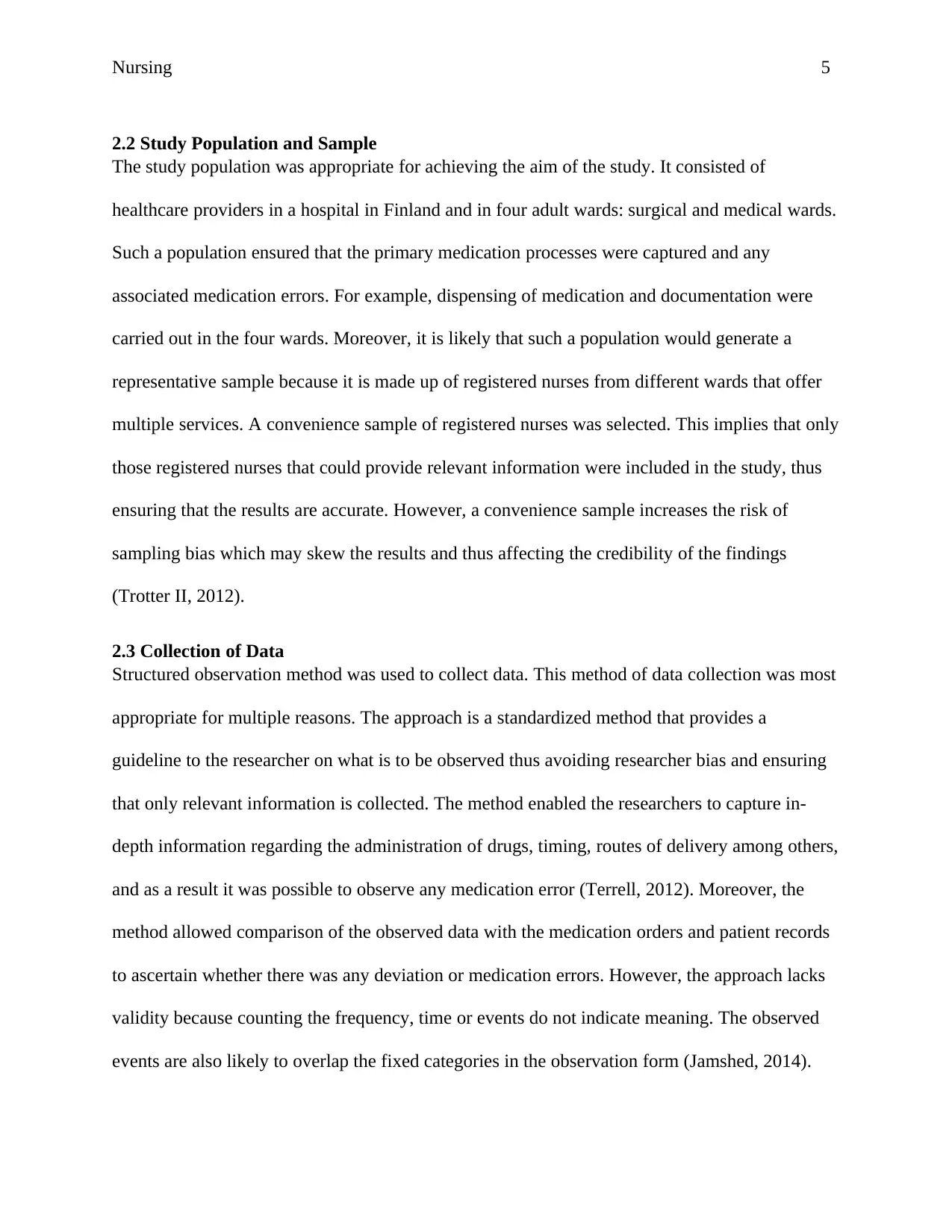
Nursing 5
2.2 Study Population and Sample
The study population was appropriate for achieving the aim of the study. It consisted of
healthcare providers in a hospital in Finland and in four adult wards: surgical and medical wards.
Such a population ensured that the primary medication processes were captured and any
associated medication errors. For example, dispensing of medication and documentation were
carried out in the four wards. Moreover, it is likely that such a population would generate a
representative sample because it is made up of registered nurses from different wards that offer
multiple services. A convenience sample of registered nurses was selected. This implies that only
those registered nurses that could provide relevant information were included in the study, thus
ensuring that the results are accurate. However, a convenience sample increases the risk of
sampling bias which may skew the results and thus affecting the credibility of the findings
(Trotter II, 2012).
2.3 Collection of Data
Structured observation method was used to collect data. This method of data collection was most
appropriate for multiple reasons. The approach is a standardized method that provides a
guideline to the researcher on what is to be observed thus avoiding researcher bias and ensuring
that only relevant information is collected. The method enabled the researchers to capture in-
depth information regarding the administration of drugs, timing, routes of delivery among others,
and as a result it was possible to observe any medication error (Terrell, 2012). Moreover, the
method allowed comparison of the observed data with the medication orders and patient records
to ascertain whether there was any deviation or medication errors. However, the approach lacks
validity because counting the frequency, time or events do not indicate meaning. The observed
events are also likely to overlap the fixed categories in the observation form (Jamshed, 2014).
2.2 Study Population and Sample
The study population was appropriate for achieving the aim of the study. It consisted of
healthcare providers in a hospital in Finland and in four adult wards: surgical and medical wards.
Such a population ensured that the primary medication processes were captured and any
associated medication errors. For example, dispensing of medication and documentation were
carried out in the four wards. Moreover, it is likely that such a population would generate a
representative sample because it is made up of registered nurses from different wards that offer
multiple services. A convenience sample of registered nurses was selected. This implies that only
those registered nurses that could provide relevant information were included in the study, thus
ensuring that the results are accurate. However, a convenience sample increases the risk of
sampling bias which may skew the results and thus affecting the credibility of the findings
(Trotter II, 2012).
2.3 Collection of Data
Structured observation method was used to collect data. This method of data collection was most
appropriate for multiple reasons. The approach is a standardized method that provides a
guideline to the researcher on what is to be observed thus avoiding researcher bias and ensuring
that only relevant information is collected. The method enabled the researchers to capture in-
depth information regarding the administration of drugs, timing, routes of delivery among others,
and as a result it was possible to observe any medication error (Terrell, 2012). Moreover, the
method allowed comparison of the observed data with the medication orders and patient records
to ascertain whether there was any deviation or medication errors. However, the approach lacks
validity because counting the frequency, time or events do not indicate meaning. The observed
events are also likely to overlap the fixed categories in the observation form (Jamshed, 2014).
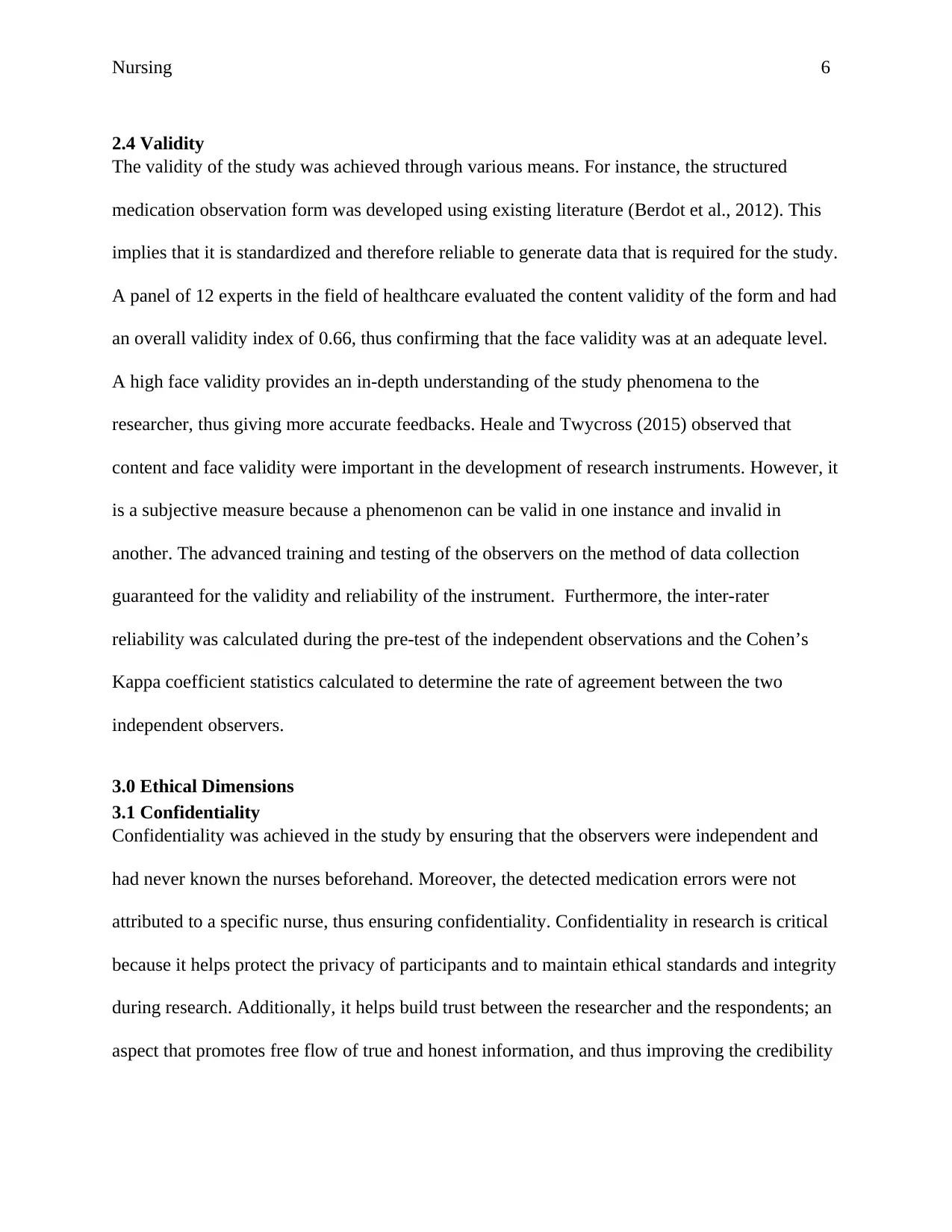
Nursing 6
2.4 Validity
The validity of the study was achieved through various means. For instance, the structured
medication observation form was developed using existing literature (Berdot et al., 2012). This
implies that it is standardized and therefore reliable to generate data that is required for the study.
A panel of 12 experts in the field of healthcare evaluated the content validity of the form and had
an overall validity index of 0.66, thus confirming that the face validity was at an adequate level.
A high face validity provides an in-depth understanding of the study phenomena to the
researcher, thus giving more accurate feedbacks. Heale and Twycross (2015) observed that
content and face validity were important in the development of research instruments. However, it
is a subjective measure because a phenomenon can be valid in one instance and invalid in
another. The advanced training and testing of the observers on the method of data collection
guaranteed for the validity and reliability of the instrument. Furthermore, the inter-rater
reliability was calculated during the pre-test of the independent observations and the Cohen’s
Kappa coefficient statistics calculated to determine the rate of agreement between the two
independent observers.
3.0 Ethical Dimensions
3.1 Confidentiality
Confidentiality was achieved in the study by ensuring that the observers were independent and
had never known the nurses beforehand. Moreover, the detected medication errors were not
attributed to a specific nurse, thus ensuring confidentiality. Confidentiality in research is critical
because it helps protect the privacy of participants and to maintain ethical standards and integrity
during research. Additionally, it helps build trust between the researcher and the respondents; an
aspect that promotes free flow of true and honest information, and thus improving the credibility
2.4 Validity
The validity of the study was achieved through various means. For instance, the structured
medication observation form was developed using existing literature (Berdot et al., 2012). This
implies that it is standardized and therefore reliable to generate data that is required for the study.
A panel of 12 experts in the field of healthcare evaluated the content validity of the form and had
an overall validity index of 0.66, thus confirming that the face validity was at an adequate level.
A high face validity provides an in-depth understanding of the study phenomena to the
researcher, thus giving more accurate feedbacks. Heale and Twycross (2015) observed that
content and face validity were important in the development of research instruments. However, it
is a subjective measure because a phenomenon can be valid in one instance and invalid in
another. The advanced training and testing of the observers on the method of data collection
guaranteed for the validity and reliability of the instrument. Furthermore, the inter-rater
reliability was calculated during the pre-test of the independent observations and the Cohen’s
Kappa coefficient statistics calculated to determine the rate of agreement between the two
independent observers.
3.0 Ethical Dimensions
3.1 Confidentiality
Confidentiality was achieved in the study by ensuring that the observers were independent and
had never known the nurses beforehand. Moreover, the detected medication errors were not
attributed to a specific nurse, thus ensuring confidentiality. Confidentiality in research is critical
because it helps protect the privacy of participants and to maintain ethical standards and integrity
during research. Additionally, it helps build trust between the researcher and the respondents; an
aspect that promotes free flow of true and honest information, and thus improving the credibility
⊘ This is a preview!⊘
Do you want full access?
Subscribe today to unlock all pages.

Trusted by 1+ million students worldwide
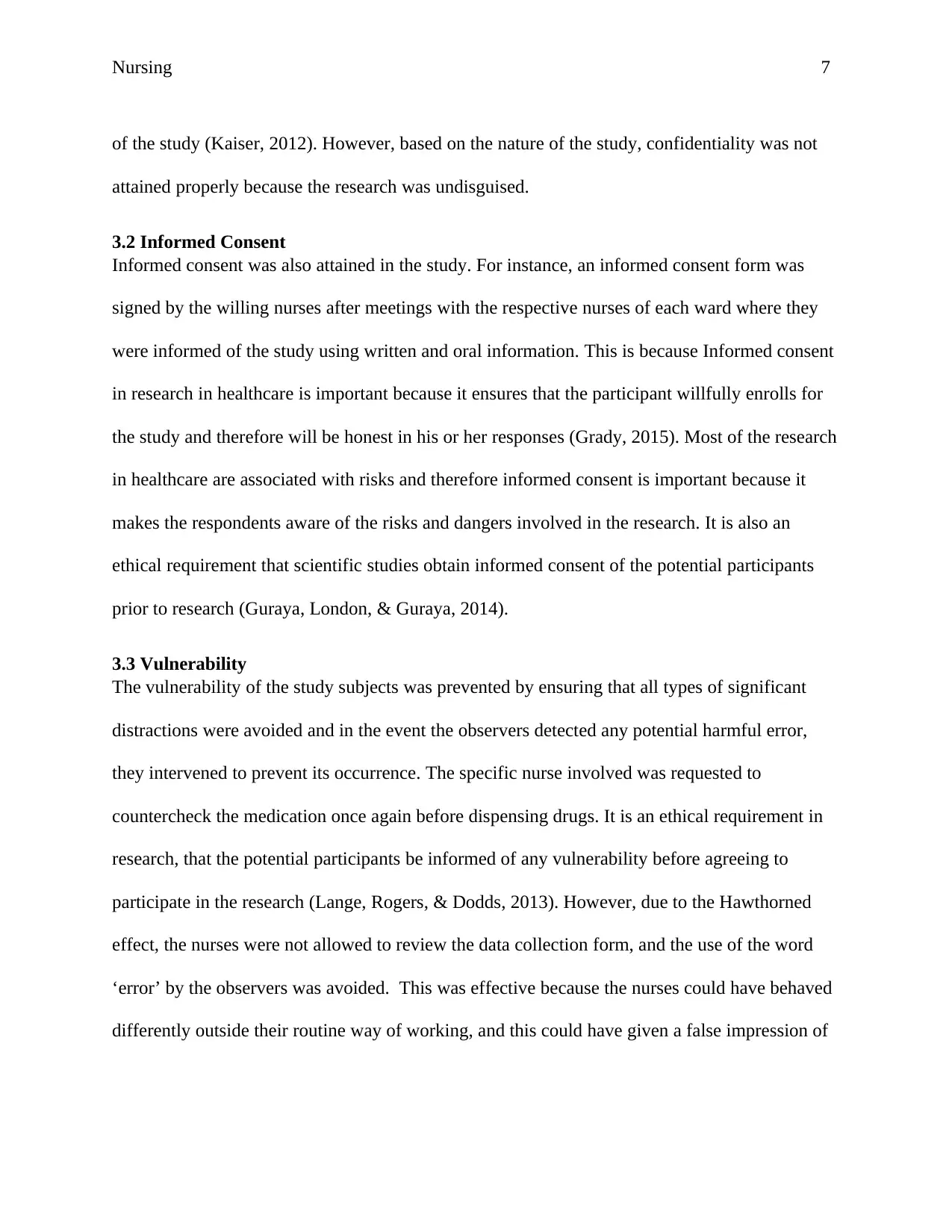
Nursing 7
of the study (Kaiser, 2012). However, based on the nature of the study, confidentiality was not
attained properly because the research was undisguised.
3.2 Informed Consent
Informed consent was also attained in the study. For instance, an informed consent form was
signed by the willing nurses after meetings with the respective nurses of each ward where they
were informed of the study using written and oral information. This is because Informed consent
in research in healthcare is important because it ensures that the participant willfully enrolls for
the study and therefore will be honest in his or her responses (Grady, 2015). Most of the research
in healthcare are associated with risks and therefore informed consent is important because it
makes the respondents aware of the risks and dangers involved in the research. It is also an
ethical requirement that scientific studies obtain informed consent of the potential participants
prior to research (Guraya, London, & Guraya, 2014).
3.3 Vulnerability
The vulnerability of the study subjects was prevented by ensuring that all types of significant
distractions were avoided and in the event the observers detected any potential harmful error,
they intervened to prevent its occurrence. The specific nurse involved was requested to
countercheck the medication once again before dispensing drugs. It is an ethical requirement in
research, that the potential participants be informed of any vulnerability before agreeing to
participate in the research (Lange, Rogers, & Dodds, 2013). However, due to the Hawthorned
effect, the nurses were not allowed to review the data collection form, and the use of the word
‘error’ by the observers was avoided. This was effective because the nurses could have behaved
differently outside their routine way of working, and this could have given a false impression of
of the study (Kaiser, 2012). However, based on the nature of the study, confidentiality was not
attained properly because the research was undisguised.
3.2 Informed Consent
Informed consent was also attained in the study. For instance, an informed consent form was
signed by the willing nurses after meetings with the respective nurses of each ward where they
were informed of the study using written and oral information. This is because Informed consent
in research in healthcare is important because it ensures that the participant willfully enrolls for
the study and therefore will be honest in his or her responses (Grady, 2015). Most of the research
in healthcare are associated with risks and therefore informed consent is important because it
makes the respondents aware of the risks and dangers involved in the research. It is also an
ethical requirement that scientific studies obtain informed consent of the potential participants
prior to research (Guraya, London, & Guraya, 2014).
3.3 Vulnerability
The vulnerability of the study subjects was prevented by ensuring that all types of significant
distractions were avoided and in the event the observers detected any potential harmful error,
they intervened to prevent its occurrence. The specific nurse involved was requested to
countercheck the medication once again before dispensing drugs. It is an ethical requirement in
research, that the potential participants be informed of any vulnerability before agreeing to
participate in the research (Lange, Rogers, & Dodds, 2013). However, due to the Hawthorned
effect, the nurses were not allowed to review the data collection form, and the use of the word
‘error’ by the observers was avoided. This was effective because the nurses could have behaved
differently outside their routine way of working, and this could have given a false impression of
Paraphrase This Document
Need a fresh take? Get an instant paraphrase of this document with our AI Paraphraser
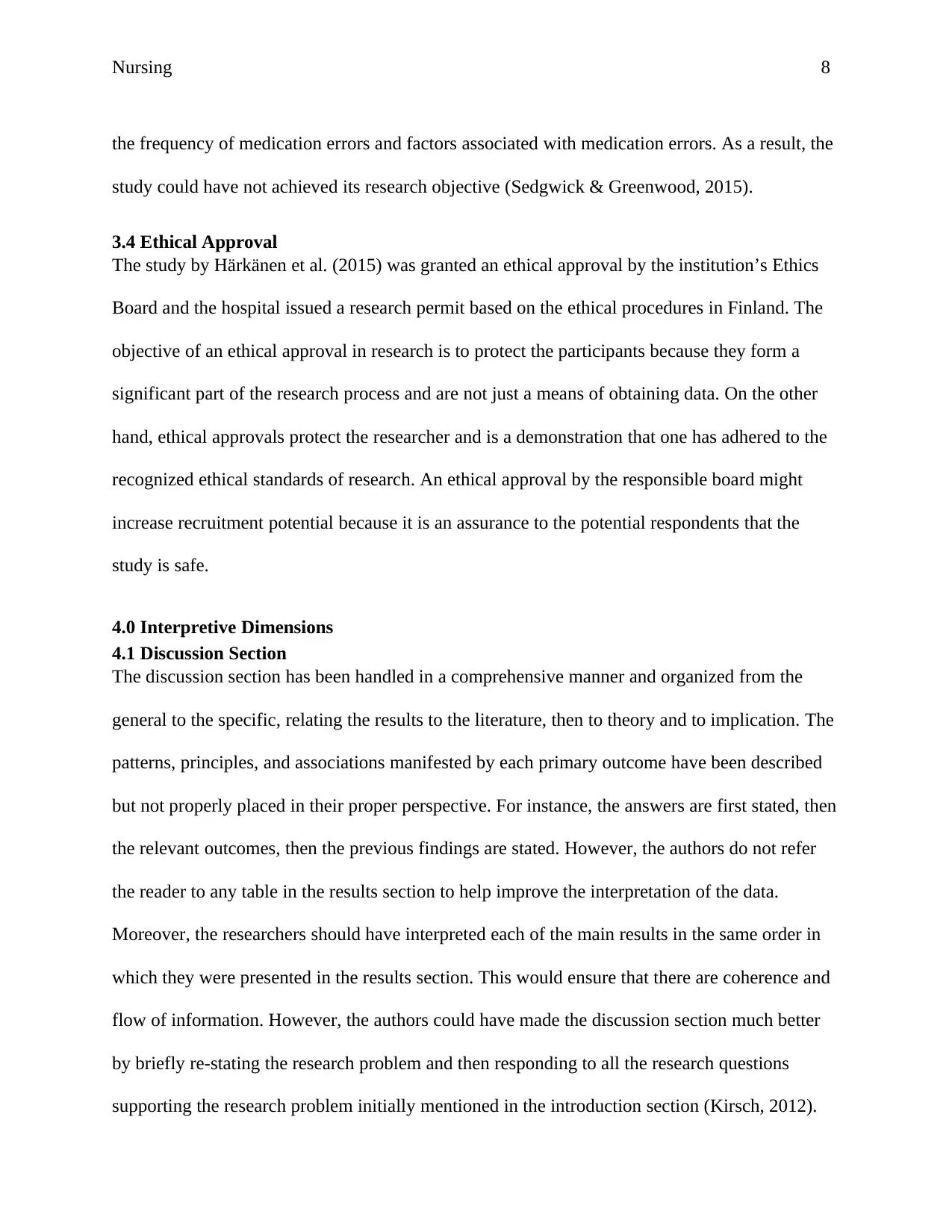
Nursing 8
the frequency of medication errors and factors associated with medication errors. As a result, the
study could have not achieved its research objective (Sedgwick & Greenwood, 2015).
3.4 Ethical Approval
The study by Härkänen et al. (2015) was granted an ethical approval by the institution’s Ethics
Board and the hospital issued a research permit based on the ethical procedures in Finland. The
objective of an ethical approval in research is to protect the participants because they form a
significant part of the research process and are not just a means of obtaining data. On the other
hand, ethical approvals protect the researcher and is a demonstration that one has adhered to the
recognized ethical standards of research. An ethical approval by the responsible board might
increase recruitment potential because it is an assurance to the potential respondents that the
study is safe.
4.0 Interpretive Dimensions
4.1 Discussion Section
The discussion section has been handled in a comprehensive manner and organized from the
general to the specific, relating the results to the literature, then to theory and to implication. The
patterns, principles, and associations manifested by each primary outcome have been described
but not properly placed in their proper perspective. For instance, the answers are first stated, then
the relevant outcomes, then the previous findings are stated. However, the authors do not refer
the reader to any table in the results section to help improve the interpretation of the data.
Moreover, the researchers should have interpreted each of the main results in the same order in
which they were presented in the results section. This would ensure that there are coherence and
flow of information. However, the authors could have made the discussion section much better
by briefly re-stating the research problem and then responding to all the research questions
supporting the research problem initially mentioned in the introduction section (Kirsch, 2012).
the frequency of medication errors and factors associated with medication errors. As a result, the
study could have not achieved its research objective (Sedgwick & Greenwood, 2015).
3.4 Ethical Approval
The study by Härkänen et al. (2015) was granted an ethical approval by the institution’s Ethics
Board and the hospital issued a research permit based on the ethical procedures in Finland. The
objective of an ethical approval in research is to protect the participants because they form a
significant part of the research process and are not just a means of obtaining data. On the other
hand, ethical approvals protect the researcher and is a demonstration that one has adhered to the
recognized ethical standards of research. An ethical approval by the responsible board might
increase recruitment potential because it is an assurance to the potential respondents that the
study is safe.
4.0 Interpretive Dimensions
4.1 Discussion Section
The discussion section has been handled in a comprehensive manner and organized from the
general to the specific, relating the results to the literature, then to theory and to implication. The
patterns, principles, and associations manifested by each primary outcome have been described
but not properly placed in their proper perspective. For instance, the answers are first stated, then
the relevant outcomes, then the previous findings are stated. However, the authors do not refer
the reader to any table in the results section to help improve the interpretation of the data.
Moreover, the researchers should have interpreted each of the main results in the same order in
which they were presented in the results section. This would ensure that there are coherence and
flow of information. However, the authors could have made the discussion section much better
by briefly re-stating the research problem and then responding to all the research questions
supporting the research problem initially mentioned in the introduction section (Kirsch, 2012).
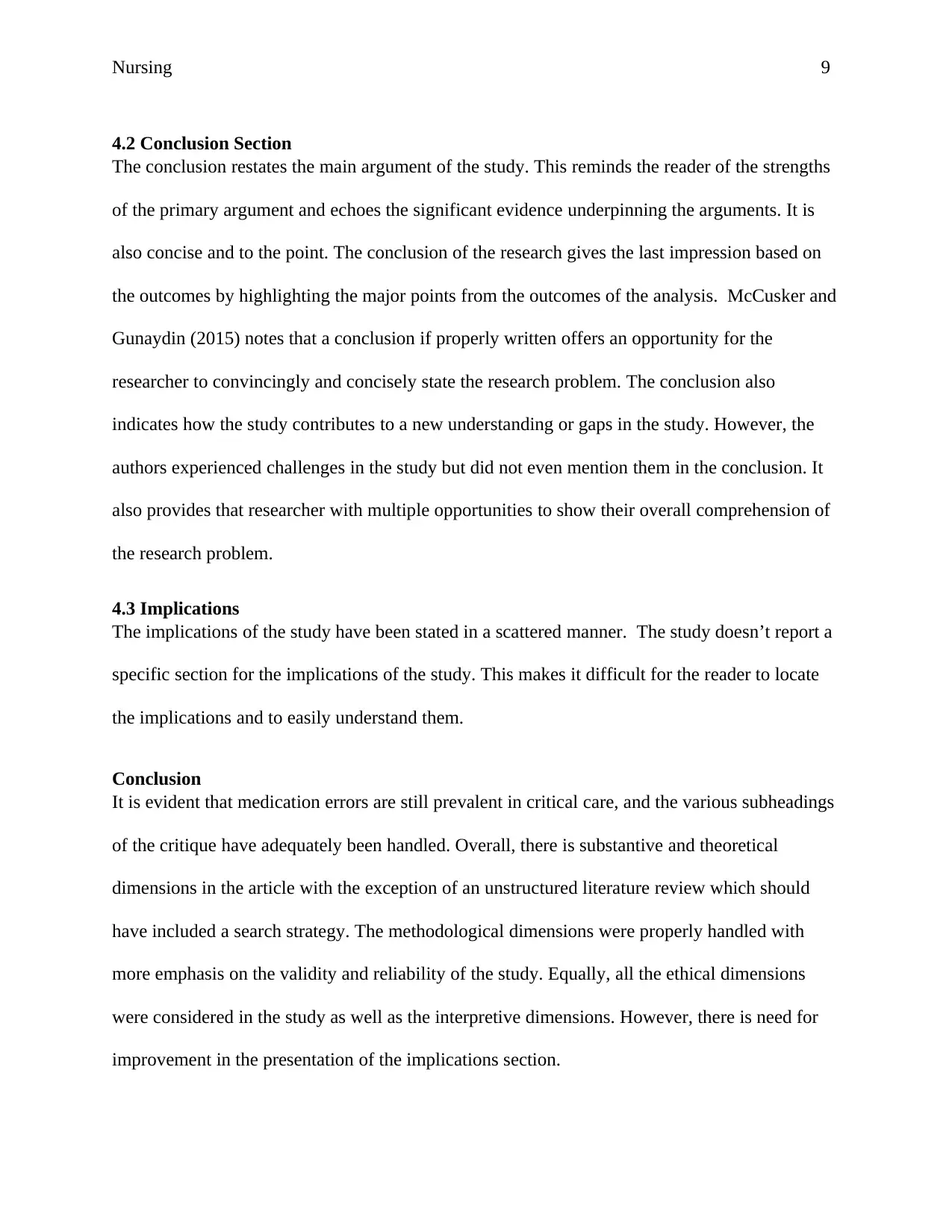
Nursing 9
4.2 Conclusion Section
The conclusion restates the main argument of the study. This reminds the reader of the strengths
of the primary argument and echoes the significant evidence underpinning the arguments. It is
also concise and to the point. The conclusion of the research gives the last impression based on
the outcomes by highlighting the major points from the outcomes of the analysis. McCusker and
Gunaydin (2015) notes that a conclusion if properly written offers an opportunity for the
researcher to convincingly and concisely state the research problem. The conclusion also
indicates how the study contributes to a new understanding or gaps in the study. However, the
authors experienced challenges in the study but did not even mention them in the conclusion. It
also provides that researcher with multiple opportunities to show their overall comprehension of
the research problem.
4.3 Implications
The implications of the study have been stated in a scattered manner. The study doesn’t report a
specific section for the implications of the study. This makes it difficult for the reader to locate
the implications and to easily understand them.
Conclusion
It is evident that medication errors are still prevalent in critical care, and the various subheadings
of the critique have adequately been handled. Overall, there is substantive and theoretical
dimensions in the article with the exception of an unstructured literature review which should
have included a search strategy. The methodological dimensions were properly handled with
more emphasis on the validity and reliability of the study. Equally, all the ethical dimensions
were considered in the study as well as the interpretive dimensions. However, there is need for
improvement in the presentation of the implications section.
4.2 Conclusion Section
The conclusion restates the main argument of the study. This reminds the reader of the strengths
of the primary argument and echoes the significant evidence underpinning the arguments. It is
also concise and to the point. The conclusion of the research gives the last impression based on
the outcomes by highlighting the major points from the outcomes of the analysis. McCusker and
Gunaydin (2015) notes that a conclusion if properly written offers an opportunity for the
researcher to convincingly and concisely state the research problem. The conclusion also
indicates how the study contributes to a new understanding or gaps in the study. However, the
authors experienced challenges in the study but did not even mention them in the conclusion. It
also provides that researcher with multiple opportunities to show their overall comprehension of
the research problem.
4.3 Implications
The implications of the study have been stated in a scattered manner. The study doesn’t report a
specific section for the implications of the study. This makes it difficult for the reader to locate
the implications and to easily understand them.
Conclusion
It is evident that medication errors are still prevalent in critical care, and the various subheadings
of the critique have adequately been handled. Overall, there is substantive and theoretical
dimensions in the article with the exception of an unstructured literature review which should
have included a search strategy. The methodological dimensions were properly handled with
more emphasis on the validity and reliability of the study. Equally, all the ethical dimensions
were considered in the study as well as the interpretive dimensions. However, there is need for
improvement in the presentation of the implications section.
⊘ This is a preview!⊘
Do you want full access?
Subscribe today to unlock all pages.

Trusted by 1+ million students worldwide
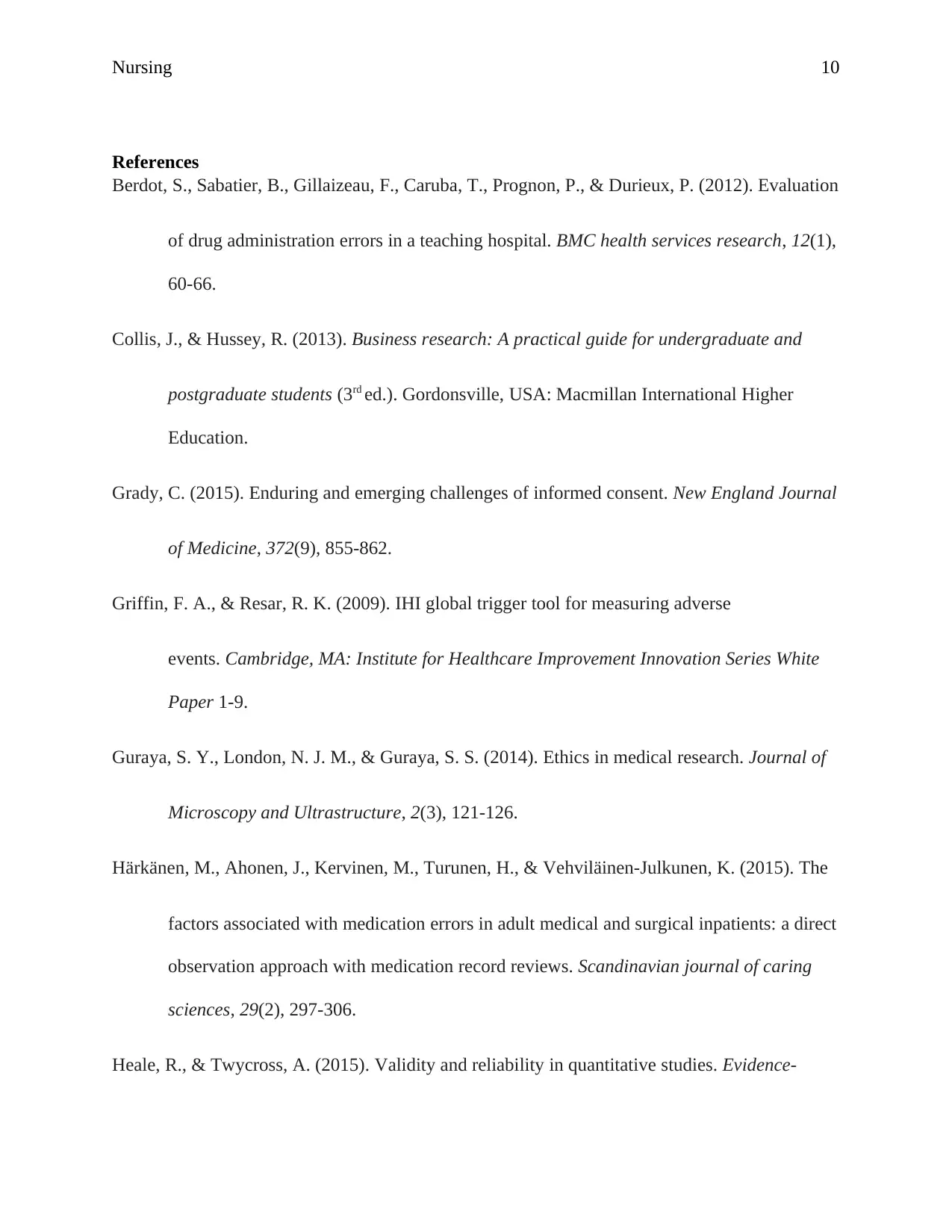
Nursing 10
References
Berdot, S., Sabatier, B., Gillaizeau, F., Caruba, T., Prognon, P., & Durieux, P. (2012). Evaluation
of drug administration errors in a teaching hospital. BMC health services research, 12(1),
60-66.
Collis, J., & Hussey, R. (2013). Business research: A practical guide for undergraduate and
postgraduate students (3rd ed.). Gordonsville, USA: Macmillan International Higher
Education.
Grady, C. (2015). Enduring and emerging challenges of informed consent. New England Journal
of Medicine, 372(9), 855-862.
Griffin, F. A., & Resar, R. K. (2009). IHI global trigger tool for measuring adverse
events. Cambridge, MA: Institute for Healthcare Improvement Innovation Series White
Paper 1-9.
Guraya, S. Y., London, N. J. M., & Guraya, S. S. (2014). Ethics in medical research. Journal of
Microscopy and Ultrastructure, 2(3), 121-126.
Härkänen, M., Ahonen, J., Kervinen, M., Turunen, H., & Vehviläinen‐Julkunen, K. (2015). The
factors associated with medication errors in adult medical and surgical inpatients: a direct
observation approach with medication record reviews. Scandinavian journal of caring
sciences, 29(2), 297-306.
Heale, R., & Twycross, A. (2015). Validity and reliability in quantitative studies. Evidence-
References
Berdot, S., Sabatier, B., Gillaizeau, F., Caruba, T., Prognon, P., & Durieux, P. (2012). Evaluation
of drug administration errors in a teaching hospital. BMC health services research, 12(1),
60-66.
Collis, J., & Hussey, R. (2013). Business research: A practical guide for undergraduate and
postgraduate students (3rd ed.). Gordonsville, USA: Macmillan International Higher
Education.
Grady, C. (2015). Enduring and emerging challenges of informed consent. New England Journal
of Medicine, 372(9), 855-862.
Griffin, F. A., & Resar, R. K. (2009). IHI global trigger tool for measuring adverse
events. Cambridge, MA: Institute for Healthcare Improvement Innovation Series White
Paper 1-9.
Guraya, S. Y., London, N. J. M., & Guraya, S. S. (2014). Ethics in medical research. Journal of
Microscopy and Ultrastructure, 2(3), 121-126.
Härkänen, M., Ahonen, J., Kervinen, M., Turunen, H., & Vehviläinen‐Julkunen, K. (2015). The
factors associated with medication errors in adult medical and surgical inpatients: a direct
observation approach with medication record reviews. Scandinavian journal of caring
sciences, 29(2), 297-306.
Heale, R., & Twycross, A. (2015). Validity and reliability in quantitative studies. Evidence-
Paraphrase This Document
Need a fresh take? Get an instant paraphrase of this document with our AI Paraphraser
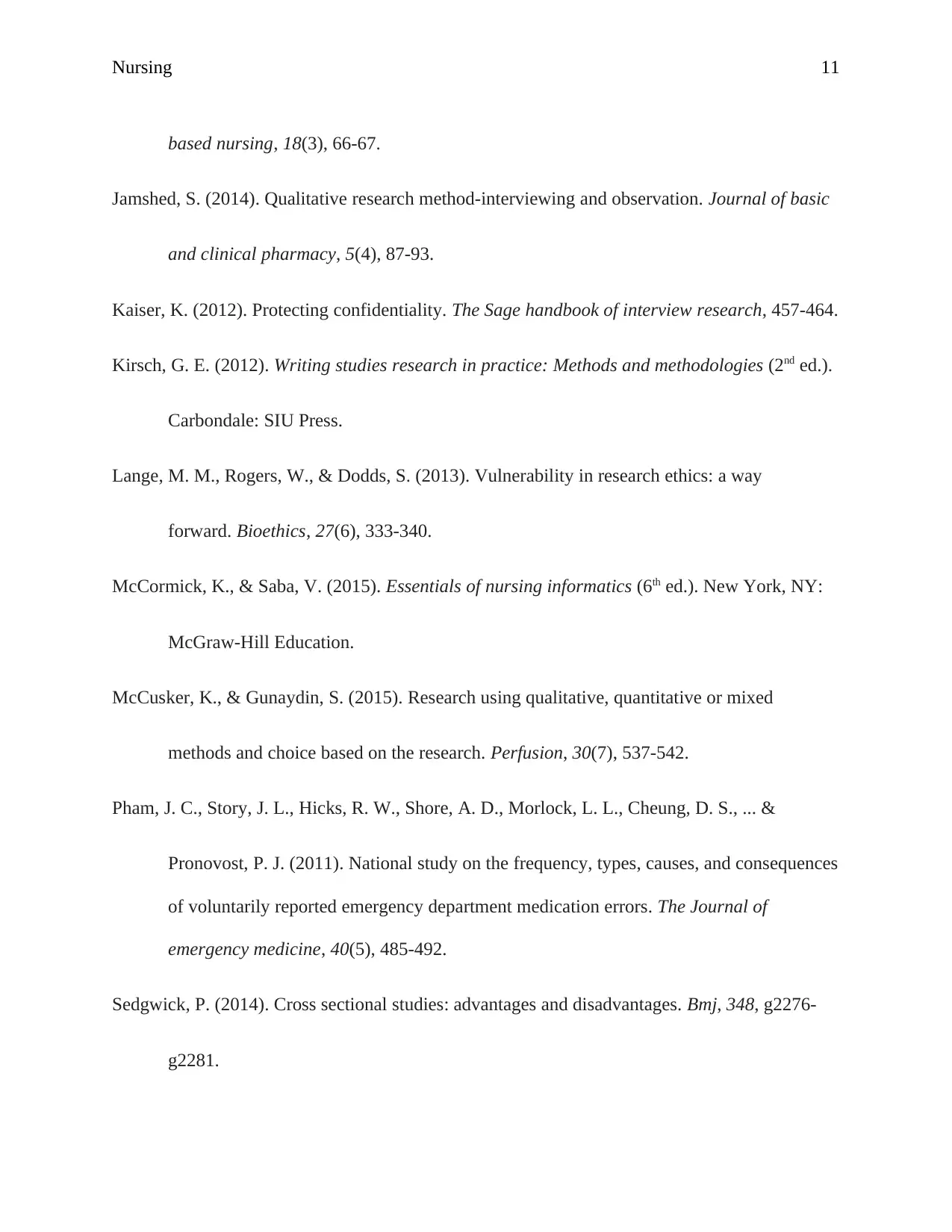
Nursing 11
based nursing, 18(3), 66-67.
Jamshed, S. (2014). Qualitative research method-interviewing and observation. Journal of basic
and clinical pharmacy, 5(4), 87-93.
Kaiser, K. (2012). Protecting confidentiality. The Sage handbook of interview research, 457-464.
Kirsch, G. E. (2012). Writing studies research in practice: Methods and methodologies (2nd ed.).
Carbondale: SIU Press.
Lange, M. M., Rogers, W., & Dodds, S. (2013). Vulnerability in research ethics: a way
forward. Bioethics, 27(6), 333-340.
McCormick, K., & Saba, V. (2015). Essentials of nursing informatics (6th ed.). New York, NY:
McGraw-Hill Education.
McCusker, K., & Gunaydin, S. (2015). Research using qualitative, quantitative or mixed
methods and choice based on the research. Perfusion, 30(7), 537-542.
Pham, J. C., Story, J. L., Hicks, R. W., Shore, A. D., Morlock, L. L., Cheung, D. S., ... &
Pronovost, P. J. (2011). National study on the frequency, types, causes, and consequences
of voluntarily reported emergency department medication errors. The Journal of
emergency medicine, 40(5), 485-492.
Sedgwick, P. (2014). Cross sectional studies: advantages and disadvantages. Bmj, 348, g2276-
g2281.
based nursing, 18(3), 66-67.
Jamshed, S. (2014). Qualitative research method-interviewing and observation. Journal of basic
and clinical pharmacy, 5(4), 87-93.
Kaiser, K. (2012). Protecting confidentiality. The Sage handbook of interview research, 457-464.
Kirsch, G. E. (2012). Writing studies research in practice: Methods and methodologies (2nd ed.).
Carbondale: SIU Press.
Lange, M. M., Rogers, W., & Dodds, S. (2013). Vulnerability in research ethics: a way
forward. Bioethics, 27(6), 333-340.
McCormick, K., & Saba, V. (2015). Essentials of nursing informatics (6th ed.). New York, NY:
McGraw-Hill Education.
McCusker, K., & Gunaydin, S. (2015). Research using qualitative, quantitative or mixed
methods and choice based on the research. Perfusion, 30(7), 537-542.
Pham, J. C., Story, J. L., Hicks, R. W., Shore, A. D., Morlock, L. L., Cheung, D. S., ... &
Pronovost, P. J. (2011). National study on the frequency, types, causes, and consequences
of voluntarily reported emergency department medication errors. The Journal of
emergency medicine, 40(5), 485-492.
Sedgwick, P. (2014). Cross sectional studies: advantages and disadvantages. Bmj, 348, g2276-
g2281.
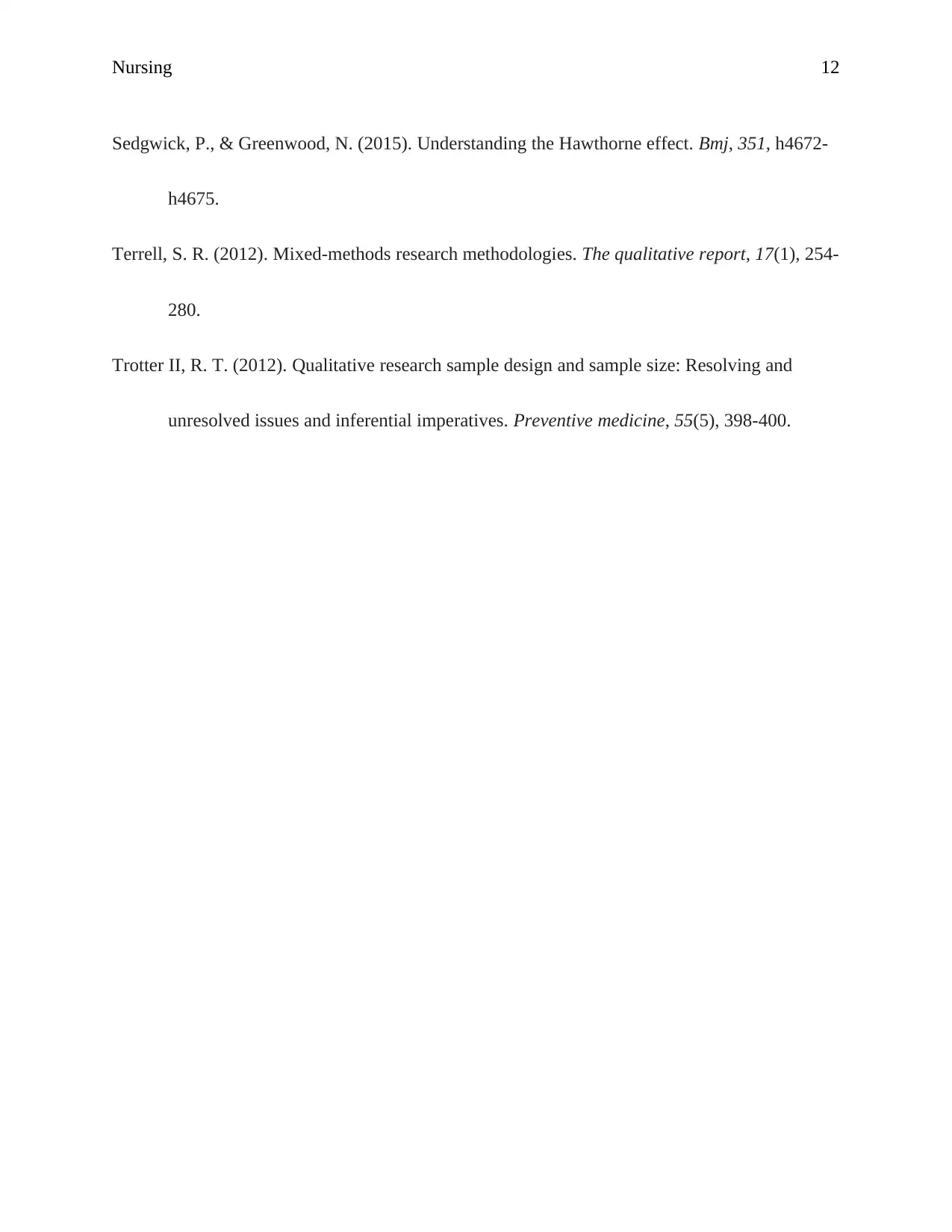
Nursing 12
Sedgwick, P., & Greenwood, N. (2015). Understanding the Hawthorne effect. Bmj, 351, h4672-
h4675.
Terrell, S. R. (2012). Mixed-methods research methodologies. The qualitative report, 17(1), 254-
280.
Trotter II, R. T. (2012). Qualitative research sample design and sample size: Resolving and
unresolved issues and inferential imperatives. Preventive medicine, 55(5), 398-400.
Sedgwick, P., & Greenwood, N. (2015). Understanding the Hawthorne effect. Bmj, 351, h4672-
h4675.
Terrell, S. R. (2012). Mixed-methods research methodologies. The qualitative report, 17(1), 254-
280.
Trotter II, R. T. (2012). Qualitative research sample design and sample size: Resolving and
unresolved issues and inferential imperatives. Preventive medicine, 55(5), 398-400.
⊘ This is a preview!⊘
Do you want full access?
Subscribe today to unlock all pages.

Trusted by 1+ million students worldwide
1 out of 12
Related Documents
Your All-in-One AI-Powered Toolkit for Academic Success.
+13062052269
info@desklib.com
Available 24*7 on WhatsApp / Email
![[object Object]](/_next/static/media/star-bottom.7253800d.svg)
Unlock your academic potential
Copyright © 2020–2025 A2Z Services. All Rights Reserved. Developed and managed by ZUCOL.





